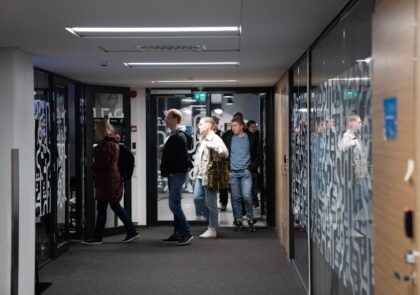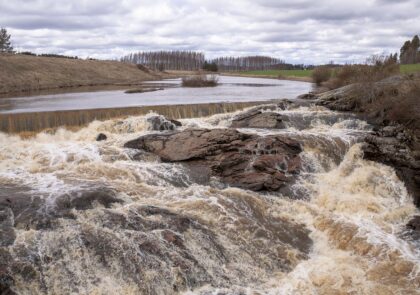
As part of the course Urban ecosystems and nature-based solutions the students of the Erasmus Mundus Master in Urban Climate and Sustainability (Murcs) spent two weeks in Germany in the spring of 2023, as well and going on excursions to Helsinki, Tampere and Turku in Finland. Throughout these visits one central task of the students was to make observations of good examples that could be used in pilot cases of the ERDF project Pilot Green, of which LAB University of Applied Sciences is a partner.
Author: Paul Carroll
The two-year master-level degree involves carrying out the course in question mostly in Lahti, but involving a two week stay organised by the partner Fachschule für Technik in Dresden. Part of this visit consisted of a two-day excursion to Berlin, where the emphasis was on visiting sites that involve green infrastructure and nature-based solutions. While the German colleague lecturers concentrated on delivering the course contents in a very practical on-site manner, the author travelled from Finland to join them and had the additional mission of integrating the contents and objectives of the PilotGreen project in the learning activities of the students.
Nature-based Solutions compared to Green Infrastructure
The terms Nature-based Solutions (NBS) and Green Infrastructure (GI) are very much inter-related but are, nevertheless, not synonymous with each other. According to the European Commission (2023) Nature-based Solutions are “Solutions that are inspired and supported by nature, which are cost-effective, simultaneously provide environmental, social and economic benefits and help build resilience”. While the organisation American Rivers (2023) defines Green infrastructure as “an approach to water management that protects, restores, or mimics the natural water cycle. Green infrastructure is effective, economical, and enhances community safety and quality of life”. However, the water aspect is only one, albeit a very typical aspects and purpose of GI. Other definitions attest to the same subtle different between the concepts, where NBS concentrates on the overall resilience of the build environment, while Green infra more specifically refers to the network of different features involved, all linked by their functions in either water management, ecosystem services and general green park and recreation areas. Though not stated in the definitions, a very large part of the function of both is to deal with the challenges of climate change. The Biodiversity -Information System for Europe (2023a) classes Green Infrastructure as coming “under the umbrella of nature-based solutions”. Figure 1 below from the same source attempts to link the concepts, although not clearly demonstrating the distinction between them, but rather their shared features. Figure 2, on the other hand, presents it from a different viewpoint, according to Baró (2016), whereby the world’s stock of natural assets, in other words Natural Capital (often expressed as in the urban context as Ecosystem Services) forms the basis for GI, which in turn forms the basis for NBS. The thinking behind this model is that the natural capital exists ipse facto, while it can be moulded by us and combined into a network as part of our living environment in many ways (GI), for which contain features can be created and added to serve our more specific purposes (such as stormwater management), either with the help of existing natural elements, or in the same way as it happens naturally (NBS).

Figure 1. The concept of green infrastructure (The Biodiversity -Information System for Europe 2023b)

Figure 2. Definitions of natural capital, green infrastructure and nature-based solutions along an operationalization gradient (Baro 2016, 14)
Lectures and presentation about urban ecosystems on location
The study visit to Berlin especially consisted of lessons in the open air, being held while moving from one example location to another. Many of these good cases of the implementation of green infrastructure were in very central locations that were developed after the reunification of Germany and the removal of the wall surrounding the former West Berlin. In locations such as in Image. 1 it was chosen to install green park areas and water features on newly available land, rather than use it for construction. Thereby the green infrastructure for the city was strengthened and a negative feature of the past, the Berlin wall and border zone was transformed into a positive ecosystem service for the citizens.

Image 1. Learning about the green infra on the banks of the Landwehr Canal in Berlin (Image: Paul Carroll)
The Murcs Erasmus Mundus students took many photos and sketches of these features from their lessons in the open air, given by the ever eager and well-informed lecturers from Dresden. Part of the programme while visiting Berlin was for the students to present their own group work on the urban ecosystem topic that they had been assigned earlier in the course, it was particularly fitting observing these presentations at different points along the urban green infrastructure itself, especially since the presentation modes needed to be creative and so not availing of the likes of the usual classroom Powerpoint or similar format.
Many of the ideas obtained on that visit were used in Lahti afterwards when planning green infrastructure solutions for the Mukkula Pilot area as part of the Pilot Green project, and serving their studies in urban sustainability (LAB University of Applied Sciences 2023).
References
American Rivers. 2023. What is Green Infrastructure. Cited 6 June 2023. Available at https://www.americanrivers.org/about/
Baró, F. 2016. Urban Green Infrastructure: Modeling and mapping ecosystem services for sustainable planning and management in and around cities. Doctoral Thesis. Universitat Autònoma de Barcelona. Cited 7 June 2023. Available at http://hdl.handle.net/10803/399173
The Biodiversity – Information system. 2023a. Green infrastructure. European Commission and European Environment Agency. Cited 6 June 2023. Available at https://biodiversity.europa.eu/green-infrastructure
The Biodiversity – Information system for Europe. 2023b. Concepts related to green infrastructure. European Commission and European Environment Agency. Cited 6 June 2023. Available at https://biodiversity.europa.eu/green-infrastructure/gi-related-concepts
European Commission. 2023. Research and Innovation. Cited 6 June 2023. Available at https://research-and-innovation.ec.europa.eu/research-area/environment/nature-based-solutions_en
Environmental Protection Agency. 2022. Green Infrastructure. Cited 6 June 2023. Available at https://www.epa.gov/green-infrastructure
LAB University of Applied Sciences. 2023. PilotGreen. Cited 14 June 2023. Available at https://lab.fi/en/project/pilotgreen
Author
Paul Carroll is a senior lecturer of environmental technology and urban sustainability at LAB University of Applied Sciences. He acts as a technology expert in the ERDF project PilotGreen. The PilotGreen project aims to add green features and the resulting benefit to dense cities. The project develops new and innovative green infrastructure solutions by testing them together with enterprise, urban municipalities and city residents.
Illustration: Learning about the green infra along former Berlin Wall no-man’s land (Image: Paul Carroll)
Published 16.6.2023
Reference to this article
Carroll, P. 2023. Inspiration from nature-based solutions on study visits for developing new green infrastructure. LAB Pro. Cited and date of citation. Available at https://www.labopen.fi/lab-pro/inspiration-from-nature-based-solutions-on-study-visits-for-developing-new-green-infrastructure/






